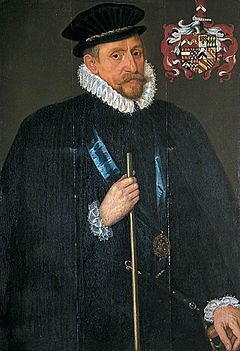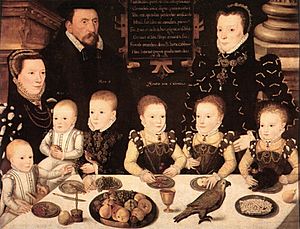William Brooke, 10th Baron Cobham facts for kids
Quick facts for kids
William Brooke, 10th Baron Cobham
|
|
|---|---|

William Brooke, 10th Baron Cobham, wearing the Collar of the Order of the Garter and holding staff of office as Lord Warden of the Cinque Ports with arms quarterly of 12 above
|
|
| Born | 1 November 1527 |
| Died | 6 March 1597 (aged 69) |
| Noble family | Brooke |
| Spouse(s) | Dorothy Nevill Frances Newton |
| Issue | Sir Maximilian Brooke Henry Brooke, 11th Baron Cobham Sir William Brooke Sir George Brooke Elizabeth Brooke, Countess of Salisbury Frances Brooke, Baroness Stourton Margaret Brooke, Lady Sondes |
| Father | George Brooke, 9th Baron Cobham |
| Mother | Anne Braye |
Sir William Brooke, the 10th Baron Cobham (born November 1, 1527 – died March 6, 1597), was an important English noble. He was a Knight of the Garter, which is a very special award. He owned the Manor of Cobham, Kent and held powerful jobs. These included being the Lord Warden of the Cinque Ports and a member of parliament for Hythe.
Even though some people thought he had strong religious views early on, he became a trusted figure. Queen Elizabeth I of England even visited him at Cobham Hall in 1559. This showed that he was accepted by the Queen's government.
Contents
Life and Career
William Brooke was the son of George Brooke, 9th Baron Cobham, who passed away in 1558. His mother was Anne Braye, Baroness Cobham, who also died in 1558.
Early Life and Education
Before 1544, William went to The King's School, Canterbury. He also studied at Queens' College, Cambridge. He spent a lot of his younger years traveling in Europe. In the early 1540s, he visited the city of Padua in Italy.
First Marriage and Early Roles
By 1545, William Brooke married Dorothy Neville. She was the daughter of George Neville, 5th Baron Bergavenny. Their marriage was not a happy one, and they separated after 1553.
Later, he served in northern France, where his father was in charge of Calais. In 1549, he joined William Paget on a special trip to Brussels.
Political Challenges and Opportunities
Like his father, William Brooke supported nobles who disagreed with Queen Mary I's religious policies. He sided with a group during Wyatt's rebellion. His brother-in-law, Henry Nevill, 6th Baron Bergavenny, helped him avoid serious trouble. In 1555, he became a Member of Parliament for Rochester.
In the late 1550s, William Brooke's career grew. His father died in 1558, and William became the 10th Baron Cobham. Soon after, his first wife Dorothy passed away. In 1560, he married Frances Newton at Whitehall. She was the daughter of Sir John Newton.
Serving Queen Elizabeth I
The new Queen, Elizabeth I, became a close friend of William Brooke. He was also good friends with William Cecil, 1st Baron Burghley, another powerful noble. When Queen Mary I of England died, Queen Elizabeth chose William Brooke to tell her husband, Philip II of Spain, about her death. This was the first of many important tasks he handled.
He became the Warden of the Cinque Ports. This job gave him a lot of power over many areas in Parliament. He was involved in several important missions and secret plans. He was briefly held under house arrest because of a small connection to the Ridolfi plot. In 1578, he joined a trip to the Low Countries that did not succeed. Later, in the late 1580s, he helped search for the writer of some controversial writings called the Martin Marprelate tracts.
Later Years and Achievements
William Brooke was made a Knight of the Garter on April 14, 1585. He also joined the Privy Council by February 12, 1586. He played a small part in the events leading to the death of Mary, Queen of Scots. During the time of the Spanish Armada, he was on a diplomatic trip to Alexander Farnese, Duke of Parma.
In 1589, his oldest daughter Elizabeth married Robert Cecil, 1st Earl of Salisbury. Robert Cecil later became a very important figure. By the early 1590s, William Brooke was less active in government. His second wife, Frances, died in 1592. He became Lord Chamberlain in August 1596, a top position in the royal household. He held this job until he passed away on March 6, 1597.
During his life, William Brooke built Cobham Hall. This large house was built in the Tudor style and stayed in his family for many years.
Family Life
William Brooke married twice.
First Marriage
His first wife was Dorothy Nevill (died September 22, 1559). She was the daughter of George Nevill, 5th Baron Bergavenny. With Dorothy, he had one daughter:
- Frances Brooke (born 1549), who married Thomas Coppinger and later Edward Becher.
Second Marriage
He then married Frances Newton. She was the daughter of Sir John Newton. With Frances, he had four sons and three daughters:
- Sir Maximilian Brooke (1560 – 1583), his oldest son, who died before his father and had no children.
- Henry Brooke, 11th Baron Cobham (1564 – 1619), who became the next Baron Cobham. He married Lady Frances Howard but had no children.
- Sir William Brooke (1565 – 1597), who was also a Member of Parliament.
- Sir George Brooke (1568 – 1603), who married Elizabeth Burgh. They had a son, William Brooke, and two daughters.
- Elizabeth Brooke (1562 – 1597), who married Robert Cecil, 1st Earl of Salisbury. They had children.
- Frances Brooke (born 1562), who married John Stourton, 9th Baron Stourton and later Sir Edward More.
- Margaret Brooke (1563 – 1621), who married Sir Thomas Sondes. They had a daughter named Frances.
After Sir Thomas Sondes passed away, Margaret and her daughter Frances lived at Cobham Hall. William Brooke asked his son Henry to look after Margaret. Sadly, Margaret became unwell later in her life.


